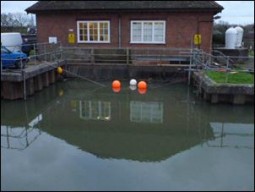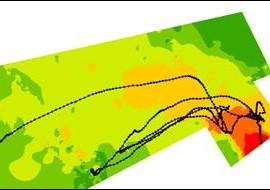It is widely recognised that high head barriers such as dams can restrict or prevent the seaward migration of silver eel. Fish may suffer injury and mortality resulting from impingement on screens or entrainment and blade strike at hydropower and pumping facilities. Eels are particularly vulnerable to these impacts due to their elongated body morphology and weak burst swimming capabilities.
Modifying flow management regimes at barriers and restricting power generation during peak migration periods can effectively reduce deleterious impacts and improve passage, but this approach relies on understanding how eel respond to different structure types and the often complex interaction of cues created around them. Further, while the impact of high head barriers has received considerable attention, relatively little is known about the importance or cumulative effects of low head structures, which are far more numerous.
An ICER research program has addressed some of these knowledge gaps. Field research using acoustic and Passive Integrated Transponder (PIT) telemetry highlighted the substantial influence that management regimes at low head structures and comparatively minor water abstraction points may have on migratory delay, entrainment loss and overall probability of seaward escapement of adult eels.
At a finer scale, sub-metre precision acoustic positioning telemetry was employed to track the movements of downstream migrating eel through manipulated flow fields within a water intake channel. Movement paths were then interrogated in relation to mapped hydrodynamics obtained using a raft mounted Acoustic Doppler Current Profiler. In the vicinity of structures eels display a wide range of behaviours including rejection and milling. It has been possible to link these behaviours to hydrodynamic features ubiquitous at riverine structures, such as velocity gradients, for the first time in a field environment. This research has been conducted in collaboration with the Environment Agency (England) and other partners.
Media:
Publications:
Piper, A.T., Wright, R.M., Walker, A. & Kemp, P.S. (2013). Escapement, route choice, barrier passage and entrainment of seaward migrating European eel, Anguilla anguilla, within a highly regulated lowland river. Ecological Engineering 57: 88-96.
Piper, A.T., Manes, C., Siniscalchi, F., Marion, A., Wright, R.M. and Kemp, P.S. (2015). Response of seaward migrating European eel (Anguilla anguilla) to manipulated flow fields. Proceedings of The Royal Society B: Biological Sciences 282: 1-9.
Piper, A.T., Svendsen, J.C., Wright, R.M. & Kemp, P.S. (2015). Movement patterns of seaward migrating European eel (Anguilla anguilla) at a complex of riverine barriers: implications for conservation. Ecology of Freshwater Fish 26: 87-98.
People:
Dr Adam Piper
Prof Paul Kemp



